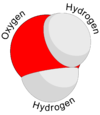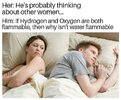D
You are using an out of date browser. It may not display this or other websites correctly.
You should upgrade or use an alternative browser.
You should upgrade or use an alternative browser.
D
Deleted member 5605
Guest
Clever.But one more ans is there inside this image.It's water..

I can only see an ASS here...


D
Deleted member 5605
Guest
Hahaa molecules structure of waterI can only see an ASS here...

 .always I m getting some new innovative ans
.always I m getting some new innovative ans
Clever.But one more ans is there inside this image.

But what @Nilaani told is correct ans na, but u told one more ans inside pic...Hahaa molecules structure of water.always I m getting some new innovative ans

D
Deleted member 5605
Guest
Yeah one more ans is there inside from that pic.But what @Nilaani told is correct ans na, but u told one more ans inside pic...
Panty 



Last edited:
Dihydrogen monoxide
D
Deleted member 5605
Guest
Yeah one more ans is there inside from that picBut what @Nilaani told is correct ans na, but u told one more ans inside pic...
Yes Di hydrogen .I m like your cleverness.Dihydrogen monoxide

Yeah exact meaning it's ratio of 2;1
Chemists Joel Rosenthal and Daniel G. Nocera of the Massachusetts Institute of Technology provide this answer.
When molecular hydrogen (H2) and oxygen (O2) are combined and allowed to react together, energy is released and the molecules of hydrogen and oxygen can combine to form either water or hydrogen peroxide. These two processes are represented by the two chemical equations shown at right. Chemists use redox half-reactions to describe thermodynamic processes like the ones embodied by such equations. For both of the reactions shown, the hydrogen molecules are oxidized and the oxygen atoms are reduced. Accordingly, each of the reactions below is described by a combination of two half-reactions--one corresponding to a chemical oxidation and another corresponding to a reduction.
The redox half-reaction for hydrogen oxidation is relatively simple and is shown on the left side of the scheme below. In this oxidation, a molecule of hydrogen gas is ionized to two electrons and two protons. Writing a half-reaction for oxygen reduction is more complicated, since oxygen can be reduced by either one, two or four electrons, as shown by the square redox scheme to the right, below. In most chemical reactions, molecular oxygen is reduced along the red and blue pathways highlighted in this redox scheme. The complete reduction of O2 by four electrons (4e- + 4H+, blue horizontal pathway) generates two equivalents of water whereas the corresponding two-electron reduction (2e- + 2H+, red diagonal pathway) yields hydrogen peroxide. Both the two- (¿G¿ = -0.695 V) and four-electron (¿G¿ = -1.229 V) reductions of O2 are energetically downhill, but more than half a volt of energy is squandered in the former reaction. Accordingly, biological processes coupled to O2 reduction, such as cellular respiration, are highly selective for the complete 4e- + 4H+ pathway in order to maximize the energy available for ATP synthesis. The selective reduction of oxygen to water in such biological systems is crucial, not only in order to maximize the energy produced for cellular metabolism but also because hydrogen peroxide is a powerful oxidant and cytotoxin, which harms living cells.

When molecular hydrogen (H2) and oxygen (O2) are combined and allowed to react together, energy is released and the molecules of hydrogen and oxygen can combine to form either water or hydrogen peroxide. These two processes are represented by the two chemical equations shown at right. Chemists use redox half-reactions to describe thermodynamic processes like the ones embodied by such equations. For both of the reactions shown, the hydrogen molecules are oxidized and the oxygen atoms are reduced. Accordingly, each of the reactions below is described by a combination of two half-reactions--one corresponding to a chemical oxidation and another corresponding to a reduction.
The redox half-reaction for hydrogen oxidation is relatively simple and is shown on the left side of the scheme below. In this oxidation, a molecule of hydrogen gas is ionized to two electrons and two protons. Writing a half-reaction for oxygen reduction is more complicated, since oxygen can be reduced by either one, two or four electrons, as shown by the square redox scheme to the right, below. In most chemical reactions, molecular oxygen is reduced along the red and blue pathways highlighted in this redox scheme. The complete reduction of O2 by four electrons (4e- + 4H+, blue horizontal pathway) generates two equivalents of water whereas the corresponding two-electron reduction (2e- + 2H+, red diagonal pathway) yields hydrogen peroxide. Both the two- (¿G¿ = -0.695 V) and four-electron (¿G¿ = -1.229 V) reductions of O2 are energetically downhill, but more than half a volt of energy is squandered in the former reaction. Accordingly, biological processes coupled to O2 reduction, such as cellular respiration, are highly selective for the complete 4e- + 4H+ pathway in order to maximize the energy available for ATP synthesis. The selective reduction of oxygen to water in such biological systems is crucial, not only in order to maximize the energy produced for cellular metabolism but also because hydrogen peroxide is a powerful oxidant and cytotoxin, which harms living cells.
Heeeee.... cpy & paste

I didn't even attempt to read it, just read last line copy paste hahaChemists Joel Rosenthal and Daniel G. Nocera of the Massachusetts Institute of Technology provide this answer.
When molecular hydrogen (H2) and oxygen (O2) are combined and allowed to react together, energy is released and the molecules of hydrogen and oxygen can combine to form either water or hydrogen peroxide. These two processes are represented by the two chemical equations shown at right. Chemists use redox half-reactions to describe thermodynamic processes like the ones embodied by such equations. For both of the reactions shown, the hydrogen molecules are oxidized and the oxygen atoms are reduced. Accordingly, each of the reactions below is described by a combination of two half-reactions--one corresponding to a chemical oxidation and another corresponding to a reduction.
The redox half-reaction for hydrogen oxidation is relatively simple and is shown on the left side of the scheme below. In this oxidation, a molecule of hydrogen gas is ionized to two electrons and two protons. Writing a half-reaction for oxygen reduction is more complicated, since oxygen can be reduced by either one, two or four electrons, as shown by the square redox scheme to the right, below. In most chemical reactions, molecular oxygen is reduced along the red and blue pathways highlighted in this redox scheme. The complete reduction of O2 by four electrons (4e- + 4H+, blue horizontal pathway) generates two equivalents of water whereas the corresponding two-electron reduction (2e- + 2H+, red diagonal pathway) yields hydrogen peroxide. Both the two- (¿G¿ = -0.695 V) and four-electron (¿G¿ = -1.229 V) reductions of O2 are energetically downhill, but more than half a volt of energy is squandered in the former reaction. Accordingly, biological processes coupled to O2 reduction, such as cellular respiration, are highly selective for the complete 4e- + 4H+ pathway in order to maximize the energy available for ATP synthesis. The selective reduction of oxygen to water in such biological systems is crucial, not only in order to maximize the energy produced for cellular metabolism but also because hydrogen peroxide is a powerful oxidant and cytotoxin, which harms living cells.
Heeeee.... cpy & paste
 bcoz I guessed it might be copy paste and am a lazy ass to read lengthyyyyyyy poooooostttttttt
bcoz I guessed it might be copy paste and am a lazy ass to read lengthyyyyyyy poooooostttttttt
D
Deleted member 5605
Guest
Thats why I m expecting always single line ans which will be stay in our mind for some extent of timeI didn't even attempt to read it, just read last line copy paste hahabcoz I guessed it might be copy paste and am a lazy ass to read lengthyyyyyyy poooooostttttttt

Chemistry.. 

T
TheOne
Guest
Well oxygen cover the main portion of it , Without oxygen ON somethg naughty can happen ....










